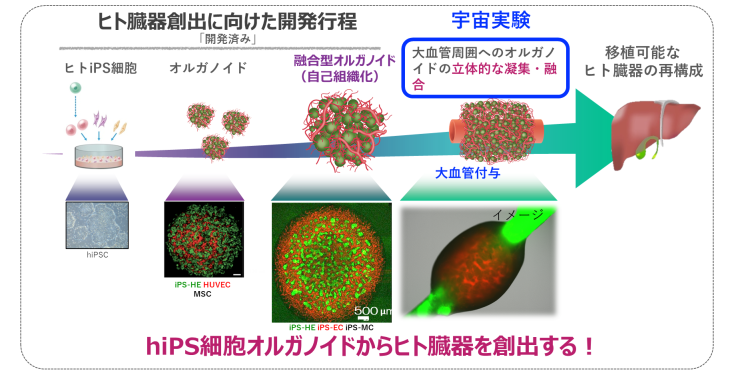ヒトiPS細胞を用いた宇宙実験によるヒト臓器創出技術の開発
我々の研究室では、細胞間相互作用を制御することでヒト人工多能性幹細胞(hiPSC)から肝臓原基(肝芽)を生み出すことに成功しており、代謝性肝疾患などへの臨床応用へ向けた開発を進めています。本プロジェクトでは、肝芽に大血管を付与することによって、より大型のヒト肝臓を創出する技術開発を行っています。微小重力環境下においては肝芽や大血管を一定の位置で保持可能であるため、組織間相互作用の惹起に有利であると考えられます。我々はhiPSC肝芽を大血管構造に集合させる新規培養技術を開発し、2020年に国際宇宙ステーションにおいて野口宇宙飛行士と共に検証実験を成功させています。次の段階として大血管周囲における肝芽の自己組織化を実証し、重力がヒト肝臓の成長や機能にどのような影響を及ぼすか試験していく予定です。
We developed a novel technology to generate liver diverticulum (liver buds) using human induced pluripotent stem cells (hiPSC) by regulating cell-cell interaction. Its clinical application to the treatment of metabolic liver diseases is in progress. In this project, we develop a method to generate a large human liver by adding large blood vessels to hiPSC-liver buds. Under the microgravity condition, the positional relation of the large blood vessel and hiPSC-liver buds can be easily maintained to be beneficial to induce tissue-tissue interactions. We developed a novel culture method to assemble hiPSC-liver buds to large blood vessels and successfully verified by the astronaut Soichi Noguchi at 1st space experiment conducted in Dec of 2020. As a next step, we will demonstrate the self-organization of hiPSC-liver buds around a large blood vessel and examine how gravity affects the growth and functions of the human liver.

